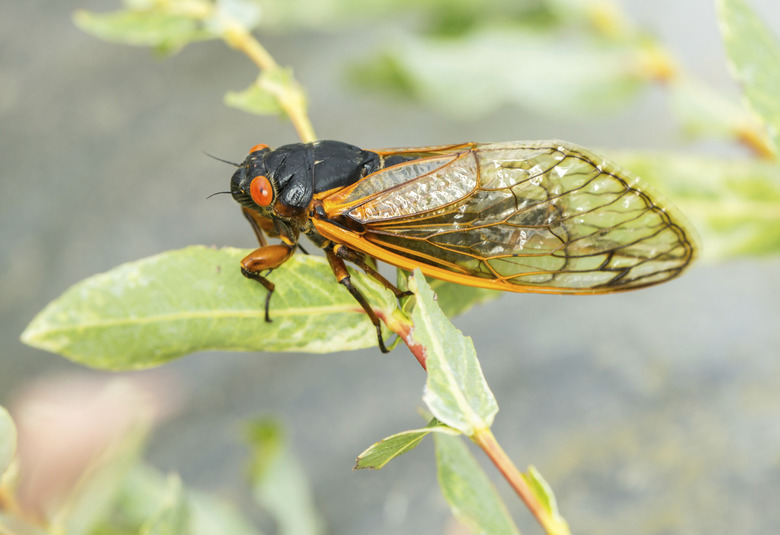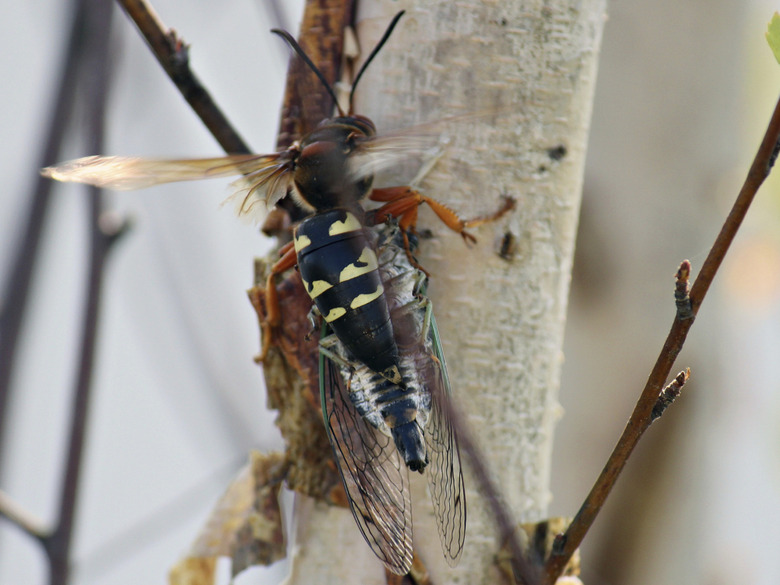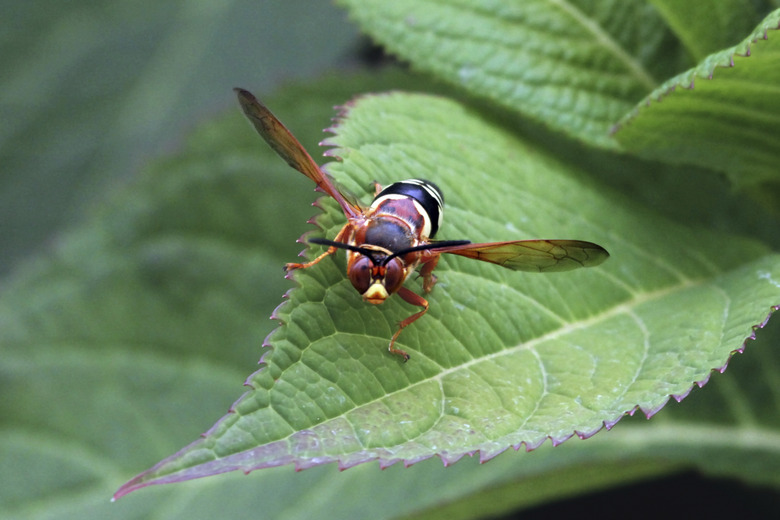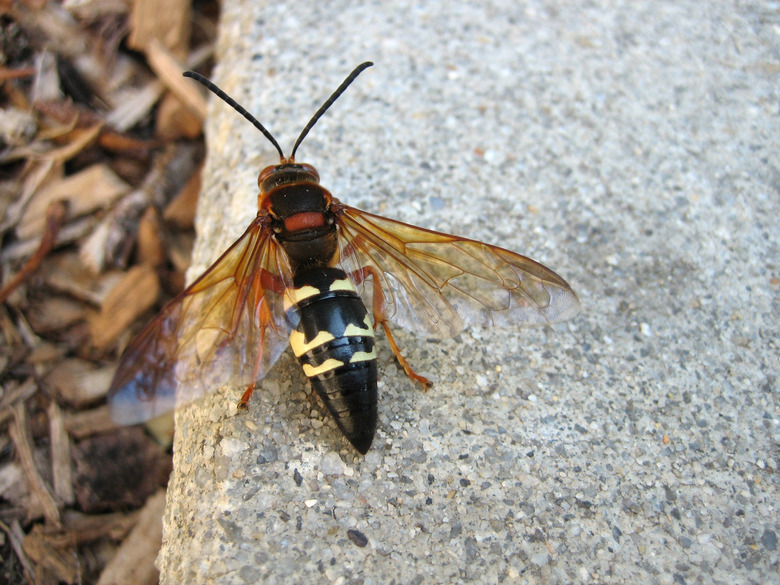What Insects Eat The Cicada Bug?
The screeching cicadas associated with the dog days of summer don't just attract hungry birds. They also have their very own insect predator, a member of the hornet family called the cicada killer wasp (Sphecius spp.). Although the adults feed only on plant liquids, the females feed paralyzed cicadas to their young.
The screeching cicadas associated with the dog days of summer don't just attract hungry birds. They also have their very own insect predator, a member of the hornet family called the cicada killer wasp (Sphecius spp.). Although the adults feed only on plant liquids, the females feed paralyzed cicadas to their young. Reaching up to 2 inches in length, the cicada killers are one of the biggest wasps in the United States. Their size and coloring — black bodies with yellow markings and reddish heads — combine to make the insects look rather menacing, but these gentle giants naturally help control cicada populations.
About Cicada Killer Wasps
Mild-mannered cicada killer wasps start emerging from the ground in early summer just after the annual cicadas start singing. After mating, the adult female wasps begin excavating new tunnels that run 12 to 15 inches below the soil. They prefer nesting in loose or sandy soils in fully sunny areas with scant vegetation. Although cicada killers are solitary wasps, you often find several nests in the same area if you have those soil conditions.
- The screeching cicadas associated with the dog days of summer don't just attract hungry birds.
- After mating, the adult female wasps begin excavating new tunnels that run 12 to 15 inches below the soil.
Each nest contains about 15 chambers, with each chamber containing one to three paralyzed cicadas and a single egg. Once a chamber is finished, the female seeks out a cicada, paralyzes it with a sting and drags it back into the prepared nesting area. The wasp then lays a single egg on a paralyzed cicada, seals up that chamber and starts tunneling out a new one.
Cicada wasp killer eggs hatch in about three days, and the young larvae feed on the cicadas for just over a week, then overwinter beneath the soil in a silken case and emerge as adults the following summer. Cicada wasp killer populations can grow quickly because about 40 percent of the larvae survive into adulthood.
Cicada Killer Wasp Benefits
Cicada killer wasps are handy garden helpers. Not only does the digging activity help aerate the soil, but in a single season, 100 adult females can also get rid of more than 16,000 annual cicadas (Tibicen spp.) that swarm yards in July and August. Annual cicadas, also called dog day cicadas, are pests that lay eggs beneath the soft bark of newly developed branches. Once hatched, cicada larvae drop to the soil, tunnel beneath the ground and feed on plant roots for about two years. Cicada egg-laying and feeding activities can damage plants and cause ornamental plants to suffer from twig dieback. Cicadas are frequently difficult to manage using traditional insecticides, and cicada wasp killers offer a practical and effective form of control. However, the wasps don't help with the periodical cicadas (Magicicada spp.) that emerge every 13 to 17 years in May or June. By the time the wasps start hunting, the periodical cicadas are long gone.
- Each nest contains about 15 chambers, with each chamber containing one to three paralyzed cicadas and a single egg.
- Cicada wasp killer eggs hatch in about three days, and the young larvae feed on the cicadas for just over a week, then overwinter beneath the soil in a silken case and emerge as adults the following summer.
Cicada Killer Wasp Drawbacks
Despite their large size and scary appearance, cicada killer wasps are not aggressive and lack the nest-protecting instincts of their hornet and honey bee relatives. You can typically walk by active wasps without them even noticing you. However, females do have stingers that they will use to protect themselves if you try to handle one or accidentally step on one. Most people report little pain with the stings, but sensitive people might experience temporary swelling. The males have no stingers, but occasionally challenge people using noisy lawn mowers or weed eaters in their territory. Although harmless, facing off with a big wasp might scare some people. Additionally, the digging activity of the females occasionally damages plant roots.
- Despite their large size and scary appearance, cicada killer wasps are not aggressive and lack the nest-protecting instincts of their hornet and honey bee relatives.
- However, females do have stingers that they will use to protect themselves if you try to handle one or accidentally step on one.
Controlling Cicada Killer Wasps
Controlling cicada killer wasps is usually unnecessary because they are beneficial insects that are active above ground only a few months out of the year. However, some people find control desirable when the wasps' digging activity injures ornamental plant roots or the cicada killers cause distress with their very presence. Drenching plant bases with water from a garden hose encourages the wasps to move to a new location and allows the soil to settle around the plant roots again.
Sprinkling 1 tablespoon of carbaryl dust pesticide around the nest entrance and directly inside the burrow can kill the insects. Wear a face mask to avoid breathing in the dust and keep kids and pets out of the treatment area until the dust settles. Dust only on calm days to prevent the particles from drifting. Carbaryl also kills bees, but you can reduce the risk of killing the pollinators by not applying dust near blooming flowers. Repeat applications every 14 days, if necessary, but not more than four times a year. Don't water the treatment area for at least 48 hours after application.
- Controlling cicada killer wasps is usually unnecessary because they are beneficial insects that are active above ground only a few months out of the year.
- However, some people find control desirable when the wasps' digging activity injures ornamental plant roots or the cicada killers cause distress with their very presence.
References
- University of Kentucky Entomology: Cicada Killer Wasps
- University of Nebraska Lincoln Extension: Cicada Killer Fact Sheet
- Galveston County Master Gardeners: Beneficials in the Garden — Cicada Killer Wasps
- North Carolina State University Cooperative Extension: Watch Out for the Cicada-Killers...They May Just Run Into You!




